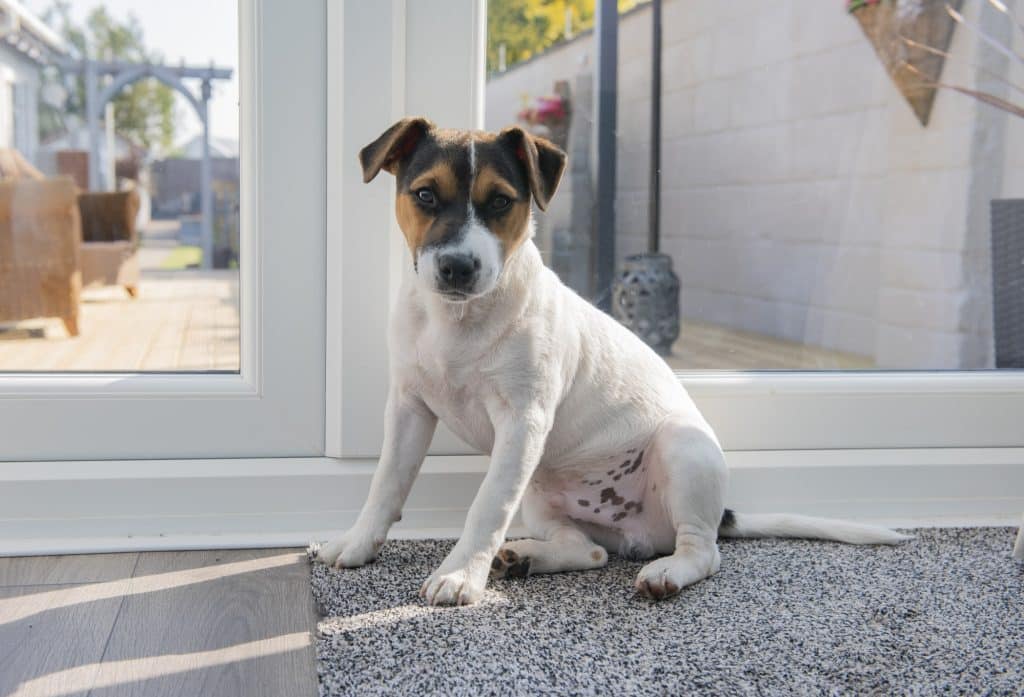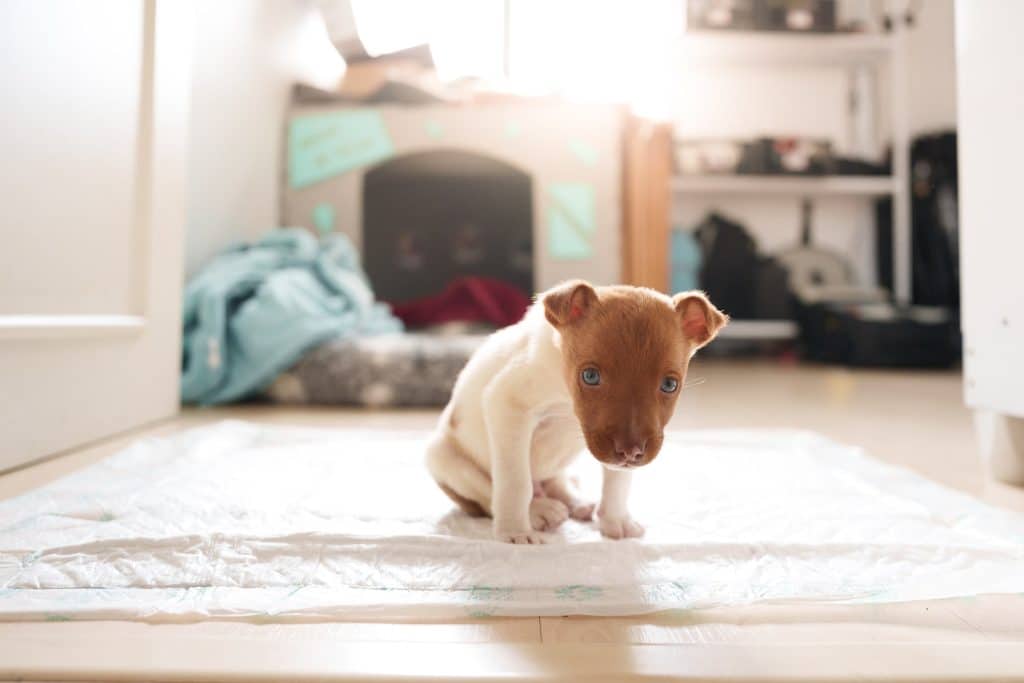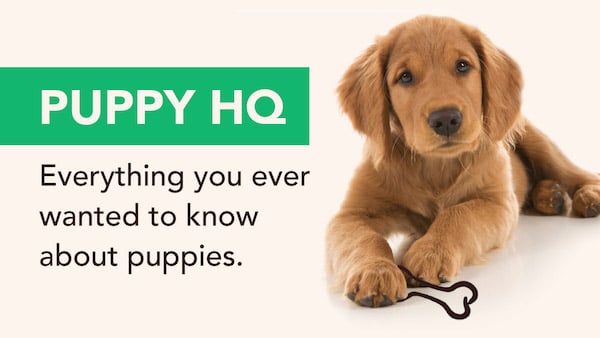- Not a substitute for professional veterinary help.
Potty training is the process in which your puppy learns how to appropriately go to the bathroom. “Potty training can take anywhere from a few weeks to a few months,” says Diana Ludwiczak, a CPDT-KA certified dog trainer and founder of Wolfie’s Place. “In some rare cases, it may take over six months.” However, in general, most puppies take 4-6 months to complete potty training. She adds that you can start potty training right away with your young pup.
Though there’s much debate on how to get your puppy acclimated to the initial potty training process, Ludwiczak says she’s found it easier to train them to go potty outside from the start. She says training puppies to go outside can be more straightforward for pet parents because it aligns with their natural behavior. It also helps establish a routine and a clear spot for elimination.
We spoke with four professional trainers about what you’ll need before potty training, the process itself, what to expect, and common problems pet parents may come across and how to resolve them.
What You’ll Need to Start Potty Training
Potty training can seem daunting for new and experienced puppy parents alike—but it doesn’t have to stink. These supplies can help make the process easier:
- Crate: A puppy crate can serve as your little one’s safe space. With crate training and positive reinforcement, they’ll see it as a place to relax and sleep, and it can be especially helpful for potty training when unsupervised.
- Puppy pads: If your puppy isn’t old enough to hold it just yet or is still making potty training progress, puppy pads are convenient for going inside when the outdoors is impossible.
- High-value treats: Treats are a great way to reward your dog when they’ve made progress in their potty training. The perfect puppy training treats should be nutritious and delicious.
- Designated potty area: A restricted area keeps your puppy’s potty training within the perimeter of your home, allowing them to roam that space without supervision. For example, dog gates can help designate a particular potty area.
- Cleaning supplies: Messes are expected when training your puppy. Pet-friendly cleaning products are among many of the puppy essentials. If you notice an accident, clean it up as soon as possible to prevent your puppy from going in that same spot again.
How to pick a potty training captain
Potty training a puppy is practically a full-time job. When considering who in the family will be in charge of potty training, Ludwiczak says the ideal person is someone who:
- Has a lot of time to devote to the process
- Can be home for the first month
- Is good at keeping routines
“They will need to be completely in tune with the new puppy,” Ludwiczak says. “This means setting their alarm to take the dog out every hour for the first few days.” Additionally, she says they should oversee the feeding schedule since most dogs will go potty right after a meal.
Lastly, she adds it’s important to make a single person responsible for overseeing the potty training process since it’ll allow for less confusion and more consistency.
Does a pup need to see a vet beforehand?
Prior to potty training your pup, it’s always a good idea to schedule a health exam with your veterinarian to rule out medical issues that can make housetraining even more difficult, especially if you notice any out-of-the-ordinary signs.
Medical conditions that can make housetraining a challenge in puppies include:
- Urinary tract infection (UTI)
- Infection
- Separation anxiety
When To Begin Puppy Potty Training
The first six months of a puppy’s life are packed with countless experiences that are crucial to their overall development—potty training being one of them.
Ideally, a puppy should start potty training around three months old. However, some can learn even younger! At this point in their growth cycle, puppies should be learning basic obedience commands and socialization. It’s also helpful if they’re crate-trained and leash-trained before they get started with potty training.
Signs a puppy is ready to begin potty training include:

iStock/StephM2506
How to Potty Train Your Puppy in 5 Easy Steps
Potty training is one of the most important dog training skills. And as much as it can be stressful, it’s incredibly rewarding once your puppy picks up on the process.
Irith Bloom, a CPDT-KSA certified professional dog trainer and behavior consultant, and owner of The Sophisticated Dog, shares these surefire puppy potty training tips:
1. Take your puppy outside at least every 30 minutes.
Having a set schedule throughout the day is imperative to your puppy picking up on potty training.
Pro tip: Bloom says to take your puppy outside on a leash once every 30 minutes, every time they eat or drink something, or after playing.
2. Wait for your dog to do their business.
Patience is key! Give your puppy some time to relieve themselves and wait to see if they do or not.
Pro tip: “Stand quietly, holding the leash, and wait for up to five minutes while watching to see if the dog pees or poops,” Bloom explains.
3. Reward them for pottying outside, or try again.
Positive reinforcement training is a type of dog training based on rewarding good behavior. If your puppy pees or poops outside, make sure to praise and offer a treat.
Pro tip: If your puppy pees or poops within those first five minutes, Bloom says to give the dog up to 15 minutes of supervised time in the house or free play time outside. However, if they don’t within the first five minutes, take them back to a confinement area in the house (e.g., a crate or a pen) for 15 minutes, then try again.
4. Repeat these steps throughout the day.
Dogs thrive with routine. Following a schedule consistently will help your puppy learn where to pee and poop.
Pro tip: “The more consistent you are, the faster the dog will learn,” Bloom reassures.
5. Track your puppy’s potty patterns.
Keeping track of your puppy’s potty schedule in a training log provides insight into their habits and needs. If you find they’re able to hold it longer as they grow up, you can change the frequency of how often they’ll need to go outside.
Pro tip: Bloom suggests creating a housetraining chart or taking notes about when and where the dog pees or poops.
How Long Does Puppy Potty Training Take?
Overall, most puppies will be fully potty trained within 4-6 months; however, this varies by breed and your puppy’s age.
For dogs taking longer with potty training, Bloom says it’s often due to either a poor potty training routine or untreated medical issues.
When is Your Puppy Fully Potty Trained?
Generally, Bloom says she considers a puppy to be potty trained once they’ve had no accidents for at least one month. A puppy has successfully learned potty training once they’ve learned to “hold it,” rather than eliminate it for reasonable amounts of time under reasonable circumstances.
However, she says this timeline varies depending on the dog. For example, smaller dogs can hold it up to a few hours, while large dogs can often hold it longer. However, neither should be expected to hold it for more than 4–5 hours.

iStock/zoranm
What To Avoid During Puppy Potty Training
Avoid displaying anger or disappointment in your voice or body language to a puppy when housetraining. If you’re angry, this causes confusion, says Sally Grottini, a professional dog trainer for over 30 years and a behaviorist with JustAnswer. Instead, simply clean the mess up with the proper cleaning agents and make sure your puppy is alright. NEVER punish a dog for a potty training accident.
“If your goal is to have your puppy potty outside, avoid using disposable pads,” says Brooke Greenberg, a CPDT-KA certified professional dog trainer and owner of Mind Body Paws. “This product confuses your puppy and delays the training process.”
Overall, Grottini and Greenberg say common pitfalls of potty training include:
- Giving your puppy free rein of the house. Confine them in a designated area if you’re unable to supervise them. They should have free rein of the house once they’re successfully potty trained.
- Not using a leash. A quality training leash can help minimize distractions and help keep your puppy focused when it’s time for them to go outside for a potty break.
- Letting a puppy go outside solo. Accompany your puppy outside and reward them once they’ve finished doing their business until they’re fully potty trained.
- Using the wrong cleaner for accidents. You’ll want to use an enzymatic cleaner to effectively neutralize a soiled area to prevent your pup from revisiting this spot.
- Providing inconsistent training. Without a stable routine or a potty command, a puppy might not understand why they’re going outside, resulting in them walking around and sniffing away. Additionally, a fearful dog may feel uncomfortable being in public places to go potty.
Potty Training FAQs
Potty training isn’t easy, but the end result is worth it. In addition to teaching your puppy a new skill, training can strengthen the bond between you and your pup.
Here are some common potty training problems pet parents experience—and how to solve them:
1. Why does my dog pee in the crate?
Most dogs don’t like to potty where they eat or sleep, Grottini says. If you notice they’re going to the bathroom in their crate, she recommends scheduling a vet visit to check for any health issues.
Otherwise, they might just need more opportunities to go. “If your dog pees in the crate, reevaluate your puppy’s potty schedule,” Greenberg says. “They need more frequent breaks.”
2. Why do my puppy like to go on walks but not pee outside?
Grottini says many dogs are encouraged to go to the bathroom while on walks solely because they smell another dog’s scent. However, she says this isn’t considered potty training.
“If your puppy goes potty on walks but not on leash, then walk your puppy on leash in your yard,” Greenberg says. After they go, she says to reward them with a walk around the neighborhood.
Lastly, make sure your dog has a well-kept designated potty area in the yard.
3. Why can’t my puppy sleep through the night without peeing?
If your puppy struggles to sleep through the night, Grottini says they might be too young to hold it or have separation anxiety.
“If you know your dog cannot hold it through the night, then try to take them out as much as possible in certain time spans,” she recommends.
Other reasons a dog may be unable to hold it throughout the night include:
- Incontinence or peeing too much (in older dogs)
- Ectopic ureter (birth defect)
- Lack of potty training (if from a rescue or breeder)
4. Why does my dog only pee on grass?
Greenberg and Grottini say that peeing only on the grass is extremely common in dogs. If a dog hasn’t been exposed to different areas of ground, they may prefer to only pee on grass.
“Either, try to find a small area of grass or order some for them, which can be placed on the patio,” Greenberg recommends.
You can also train a potty command, Grottini adds, so that when it’s time for your dog to do their business, they can go anywhere. It’s also a great idea to get them used to walking on pavement, rocks, wooded areas, carpeted areas, etc.
5. Why does my dog run back inside before they’re finished pooping/peeing?
If your dog has some unfinished business to do outside before doing zoomies in the living room, Grottini and Greenberg say this can happen for the following reasons:
- The door was left open, allowing them to come back in
- They were interrupted
- They got too distracted by sounds and sights in the area
To solve this, Grottini says to change the potty area to a quieter spot. Additionally, she says to keep your puppy near you for no more than ten minutes and take them out again.

iStock/Capuski
6. Why does my dog pee when they’re excited or submissive?
If your dog can’t help but pee when they’re excited, you can take them outside for greetings. Additionally, Grottinit says ignoring your puppy for 20-30 minutes can help them decompress.
Meanwhile, if your dog is submissive, Greenberg says don’t make a big deal out of comings, goings, or putting the leash on.
7. Why does my dog take forever to pick a spot?
If it feels like your dog takes forever to pick a spot, they might not have a special spot to go potty in the yard or have so much space and freedom that they don’t know why they’re outside or where exactly to go.
Greenberg recommends taking them to the same spot each time to poop and pee. This ensures they’ll understand why they’re going outside. Additionally, Grottini says if your dog’s fearful, create a designated potty area with fencing and cover it with a tarp so they can’t see out.
8. Why won’t my dog pee while on a leash?
Grottini and Greenberg explain that some dogs might not pee when they’re on a leash due to too much spatial pressure, being too distracted, or feeling frightened and trapped.
Consider getting a lightweight training lead that’s about 20 feet long, so they don’t feel your weight on the leash and feel like they have more space during their private time. Grottini says you can get your pup used to this type of leash by putting it on and playing games out in the yard with it.
Eventually, you can reel in the leash till it’s the length of a regular leash.
Takeaway
Potty training is an essential part of being a puppy parent. From prep to troubleshooting, potty training is very hands-on. However, it’s not a one-size-fits-all process, so if you ever feel lost or like you’re not making progress, enlist the help of a qualified dog trainer.



